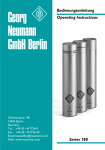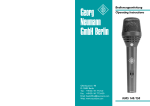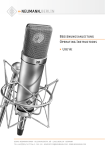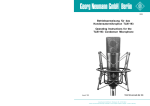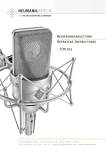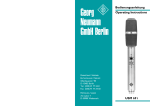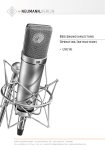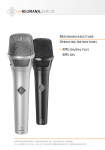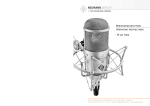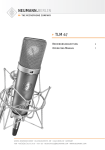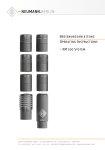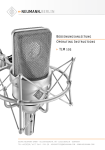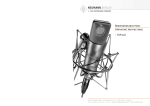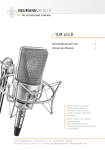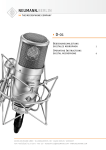Download Bedienungsanleitung Operating Instructions TLM 103
Transcript
Bedienungsanleitung Operating Instructions Ollenhauerstr. 98 D-13403 Berlin Tel.: +49-30 / 41 77 24-0 Fax: +49-30 / 41 77 24-50 Email: [email protected] Web: www.neumann.com TLM 103 Inhaltsverzeichnis Table of Contents 1. Kurzbeschreibung 1. A Short Description 2. Das Kondensatormikrophon TLM 103 2. The TLM 103 Condenser Microphone 2.1 Ausführungsformen und Beschaltung des Ausganges 2.1 Microphone Versions and Output Wiring 2.2 Mikrophonkabel 2.2 Microphone Cables 3. 3. Stromversorgung Power Supply 3.1 Phantomspeisung 3.1 Phantom Powering 3.2 Betrieb mit Netzgeräten 3.2 ac Supply Operation 3.3 Batteriespeisung 3.3 Battery Powering 3.4 Betrieb an unsymmetrischen oder mittengeerdeten Eingängen 3.4 Operation with Unbalanced or Center Tap Grounded Inputs 4. Technische Daten TLM 103 4. 5. Einige Hinweise zur Pflege von Mikrophonen 5. Some Remarks on Maintenance 6. Frequenzgang und Polardiagramm 6. Frequency Response and Polar Pattern 7. Zubehör 7. Accessories TLM 103 Technical Specifications 2. Das Kondensatormikrophon TLM 103 2. The TLM 103 Condenser Microphone Das Kondensatormikrophon TLM 103 ist ein Studiomikrophon der Serie fet 100 mit der Richtcharakteristik Niere. The TLM 103 condenser microphone is a studio microphone of the fet 100 series with a cardioid polar pattern. Die Buchstaben TLM stehen für Transformatorloses Mikrophon. The letters TLM stand for Transformerless Microphone. Der zur Leistungsanpassung der Mikrophonausgangsspannung an die Betriebsspannung üblicherweise verwendete Übertrager ist im TLM 103 durch eine elektronische Schaltung ersetzt, die – wie ein Übertrager – für eine gute Unsymmetriedämpfung sorgt. Daher werden Störsignale, die auf die symmetrische Modulationsleitung einwirken, wie gewohnt unterdrückt. The transformer which used to couple a microphone’s output to the supply voltage, was replaced in the TLM 103 by an electronic circuit which, like a transformer, maintains the excellent common mode rejection (CMR). Interference induced in the balanced modulation line is therefore suppressed as usual. Die Eigenstörspannung des TLM 103 konnte gegenüber vergleichbaren Mikrophontypen stark gesenkt werden, wobei das Mikrophon Schalldruckpegel von 138 dB unverzerrt überträgt und einen Dynamikumfang von 131 dB zur Verfügung stellt (nach DIN/IEC 651). The self-noise level of the TLM 103 is much lower than that of comparable microphone models while its overload capability extends to 138 dB SPL, providing a dynamic range of 131 dB (DIN/IEC 651). Das TLM 103 wird von der Vorderseite besprochen, die durch das Neumann-Logo gekennzeichnet ist. The TLM 103 is addressed from the front, marked with the Neumann logo. Die im Drahtgeflechtkorb des Mikrophons befindliche Großmembrankapsel K 103 besitzt einen bis ca. 5 kHz ebenen Frequenzgang und im darüberliegenden Frequenzbereich eine breite, flache Präsenzanhebung von 4 dB. Die Kapsel basiert auf der des Mikrophons U 87, indem deren Elektrode und Membran Verwendung finden. Its grille houses the large diaphragm K 103 capsule. It has a linear frequency response up to some 5 kHz with a wide flat presence boost of 4 dB at the top end. The capsule is based on that of the U 87 microphone and and uses their back electrode and diaphragm. No resonance effects are used to obtain the characteristics mentioned above. As a consequence, the microphone features excellent transient behavior and transmits all transient phenomena of music or voice without distortion. 1. Kurzbeschreibung 1. A Short Description Das Kondensatormikrophon TLM 103 ist ein Studiomikrophon mit der Richtcharakteristik Niere. The TLM 103 is a studio condenser microphone with cardioid polar pattern. Es zeichnet sich aus durch extrem niedriges Eigengeräusch und höchste Aussteuerbarkeit, transformatorlose Schaltungstechnik, besonders saubere, freie und verfärbungsfreie Klangübertragung. Its most important features are extraordinarily low self noise level combined with highest output capability, transformerless circuit, extraordinarily true sound transduction, free of coloration. Das Mikrophon hat einen symmetrischen, übertragerlosen Ausgang. Der 3-polige XLR-Steckverbinder hat folgende Belegung: The microphone has a balanced, transformerless output. The 3-pin XLR connector has the following pin assignments: Da zum Erreichen der genannten Mikrophoneigenschaften keine Resonanzwirkungen genutzt werden, ist das Impulsverhalten des Mikrophons ausgezeichnet, und es vermag alle Ausgleichsvorgänge in Musik und Sprache unverfälscht zu übertragen. Stift 1: 0 V/Masse Pin 1: 0 V/ground Die Kapsel ist zum Schutz gegen Körperschallübertragung elastisch gelagert. In order to protect the capsule from mechanical shock transmission it is elastically suspended. Stift 2: Modulation (+Phase) Pin 2: Modulation (+phase), Stift 3: Modulation (-Phase). Pin 3: Modulation (-phase). Da der Verstärker des TLM 103 bis unter 20 Hz linear verläuft, können auch extrem niederfrequente Signale unverfälscht übertragen werden. As the TLM 103‘s amplifier is linear also below 20 Hz, extremely low frequency signals can be transmitted without distortion as well. Andererseits ist das Mikrophon dadurch empfindlicher für tieffrequente Störungen wie Körperschall oder Popund Windgeräusche. Daher empfiehlt sich eventuell die Verwendung der elastischen Aufhängung EA 1 (mt), des Popschirms PS 10 oder PS 20 oder des Windschutzes WS 87. On the other hand the microphone is therefore more sensitive to low-frequency noises like structure-borne or wind and pop disturbances. For specific applications it is therefore recommended to use protective accessories as the EA 1 (mt) elastic suspension, the PS 10 or PS 20 pop screens or the WS 87 windscreen. Feldübertragungsfaktor 21 mV/Pa = – 34 dB re. 1V/Pa. Das Mikrophon wird mit 48 V, 3 mA phantomgespeist (DIN 45 596 bzw. IEC 268-15). The output sensitivity is 21 mV/Pa = – 34 dB re. 1V/Pa. The microphone is phantom powered from 48 V, 3 mA (IEC 268-15/DIN 45596). Das TLM 103 wird von der Vorderseite besprochen, die durch das Neumann-Logo gekennzeichnet ist. The TLM 103 is addressed from the front, marked with the Neumann logo. Das Mikrophon wird in einem Holzetui zusammen mit dem Stativgelenk SG 1 geliefert. The microphone comes in a wooden case including the SG 1 swivel mount. 2 3 2.1 Ausführungsformen und Beschaltung des Ausganges 2.1 Microphone Versions and Output Wiring TLM 103 .............................. ni ............................... Best.-Nr. 08430 Das Mikrophon TLM 103 besitzt eine nickelmatte Oberfläche und ist mit einem 3-poligen XLR-Steckverbinder ausgerüstet. Die Zuordnung der Mikrophonanschlüsse entspricht DIN 45 599, Kennzeichen I bzw. IEC 268-12 (pin. conn. 130-x-IEC 02): TLM 103 .............................. ni ................................ Cat. No. 08430 The TLM 103 microphone has a matt satin finish and is equipped with a 3-pole XLR connector. The microphone is wired per IEC 268-12 (pin conn. 130-xIEC 02) or DIN 45 599 I, respectively: Die Modulationsadern liegen an Stift 2 und 3, die Abschirmung an Stift 1. Modulation is connected to pins 2 and 3, the shield to pin 1. Bei einem Schalldruckanstieg vor der Mikrophonmembran tritt an Stift 2 eine positive Spannung auf. A sudden sound pressure rise in front of the diaphragm causes a positive voltage to appear at pin 2. TLM 103 mt ...................... sw ............................. Best.-Nr. 08431 Wie oben, jedoch schwarzmatte Oberfläche. TLM 103 mt ...................... blk .............................. Cat. No. 08431 As above, but with matt black finish. 2.2 Mikrophonkabel 2.2 Microphone Cables Die akustischen Eigenschaften der Mikrophone werden auch durch sehr lange (Neumann-) Kabel nicht beeinflußt. Erst bei Kabellängen deutlich über 300 m macht sich ein Abfall im oberen Frequenzbereich bemerkbar. The electroacoustic properties of the microphones are not affected even by very long (Neumann) cables. However, if cables are well over 300 m, a fall-off in the upper frequency range becomes apparent. Neumann bietet ein vielfältiges Kabelsortiment an, von dem hier ein Ausschnitt erwähnt wird. Andere als die genannten Kabellängen sowie Kabelmaterial ohne Armaturen sind auf Wunsch lieferbar. Neumann offers a wide range of cables. Only a selection is presented here. Other cable lengths or cable materials without connectors are available on request. Für das Mikrophon TLM 103 stehen folgende Kabel zur Verfügung: The following cables are available for the TLM 103 microphone: IC 3 mt ................................. sw ............................. Best.-Nr. 06543 10 m langes Mikrophonkabel, Durchmesser 5 mm, mit Doppeldrallumspinnung als Abschirmung. Schwarzmatte 3-polige XLR-Steckverbinder. Führt am Ausgang des Netzgerätes die Modulation weiter. IC 3 mt ................................. blk .............................. Cat. No. 06543 10 m long microphone cable, 5 mm in diameter, with double twist (double helix) braiding as shield. Threepin XLR connectors, matt black. For feeding the audio signal to mixing consoles, etc. IC 31 mt (5 m) ............... sw ............................. Best.-Nr. 06570 5 m langes Mikrophonkabel, Durchmesser 4,5 mm, mit Doppeldrallumspinnung als Abschirmung. Schwarzmatte 3-polige XLR-Steckverbinder. Zur Vermeidung von Reibgeräuschen bei der Verwendung an der Angel oder an Kunststoffdurchführungen (z.B. bei Windschutzkörben) ist das Kabel textilumsponnen. IC 31 mt (5 m) ............... blk .............................. Cat. No. 06570 5 m long microphone cable, 4.5 mm in diameter, with double twist braiding for screening. 3-pin XLR connectors, matte black. This cable is textile-braided to avoid frictional noise due to the handling of booms or plastic leadings (for example in windscreens). IC 4 (10 m) ....................... ni ............................... Best.-Nr. 06547 IC 4 mt (10 m) ............... sw ............................. Best.-Nr. 06557 10 m langes Mikrophonkabel für Mikrophone mit Gewindeanschluß, Durchmesser 5 mm, mit Doppeldrallumspinnung als Abschirmung. Dreh- und schwenkbares Stativgelenk SGCD 3 (mt), 3-polige XLR-Steckverbinder, der Gewindeanschluß hat 5/8"-27-Gang. Ein Adapter für 1/2"- und 3/8"-Gewindezapfen wird mitgeliefert. IC 4 (10 m) ....................... ni ................................ Cat. No. 06547 IC 4 mt (10 m) ............... blk .............................. Cat. No. 06557 10 m long microphone cable, 5 mm in diameter, with double twist braiding for screening. 3-pin XLR connectors and SGCD 3 rotatable swivel mount. It has a 5/8"-27 female thread that can be fastened to tripods. A threaded adapter for 1/2"- and 3/8" studs is included. Designed for microphones with a thread. 4 AC 22 (0,3 m) ....................................................... Best.-Nr. 06598 Adapterkabel mit einer 5-poligen XLR-Buchse und einem 3,5 mm Stereoklinkenstecker, unsymmetrisch, für den Anschluß des 5-poligen XLR-Ausganges des Speisegerätes BS 48 i-2 oder der Matrixbox MTX 191 A an Geräte mit 3,5 mm Stereoklinkenbuchse. Vorgesehen für alle Mikrophone der Serien fet 80/100 und KM 100 F mit Ausnahme der Ausgangsstufe KM 100 und des GFM 132. AC 22 (0.3 m) ........................................................ Cat. No. 06598 Adapter cable with a 5-pin XLR connector on one end and an unbalanced 3.5 mm stereo jack on the other end. It is used to connect the 5-pin XLR output of the BS 48 i-2 power supply or the MTX 191 A matrix amplifier to units with a 3.5 mm stereo input. It is designed for all microphones of the fet 80/100 series and KM 100 F, excluding the KM 100 and the GFM 132. AC 25 (0,3 m) ....................................................... Best.-Nr. 06600 Adapterkabel mit einer 3-poligen XLR-Buchse und einem 6,3 mm Monoklinkenstecker, unsymmetrisch, für den Anschluß des 3-poligen XLR-Ausganges eines Speisegerätes BS 48 i oder N 48 i-2 an Geräte mit 6,3 mm Monoklinkenbuchse. Vorgesehen für alle fet 80/100-Mikrophone und KM 100 F mit Ausnahme der Ausgangsstufe KM 100 und des GFM 132. AC 25 (0.3 m) ........................................................ Cat. No. 06600 Adapter cable with 3-pin XLR connector and a 6.3 mm monojack, unbalanced. It is used to connect 3-pin XLR outputs of the BS 48 i or N 48 i-2 power supplies to units with a 6.3 mm monojack input. Designed for all microphones of the fet 80/100 series and KM 100 F, excluding the KM 100 output stage and the GFM 132 boundary-layer microphone. AC 27 (0,3 m) ....................................................... Best.-Nr. 06602 Y-Kabel mit einer 5-poligen XLR-Buchse und zwei 6,3 mm Monoklinkensteckern, unsymmetrisch, für den Anschluß des 5-poligen XLR-Ausganges eines Speisegerätes BS 48 i-2 oder der Matrixbox MTX 191 A an Geräte mit 6,3 mm Monoklinkenbuchsen. Vorgesehen für alle fet 80/100-Mikrophone und KM 100 F mit Ausnahme von KM 100 und GFM 132. AC 27 (0.3 m) ........................................................ Cat. No. 06602 Y-cable with a 5-pin XLR connector and two 6.3 mm monojacks, unbalanced. It is used to connect 5-pin XLR outputs of the BS 48 i-2 power supply or the MTX 191 A matrix amplifier to units with 6.3 mm monojack inputs. Designed for all microphones of the fet 80/100 series and KM 100 F, excluding the KM 100 and the GFM 132. 3. Stromversorgung 3. Power Supply 3.1 Phantomspeisung 3.1 Phantom Powering Die Mikrophone der Serie fet 100 werden mit 48 V phantomgespeist (P48, IEC 1938). The fet 100 series microphones are phantom-powered at 48 V (P48, IEC 1938). Bei der Phantomspeisung fließt der Speisestrom vom positiven Pol der Spannungsquelle über die elektrische Mitte der beiden Modulationsadern zum Mikrophon. Er wird hierzu über zwei gleich große Widerstände beiden Tonadern gleichsinnig zugeführt. Die Rückleitung des Gleichstroms erfolgt über den Kabelschirm. Zwischen beiden Modulationsadern besteht also keine Potentialdifferenz. Daher ist mit der Phantomspeisung eine kompatible Anschlußtechnik möglich: Auf die Anschlußdosen können wahlweise auch dynamische Mikrophone oder Bändchenmikrophone sowie die Modulationskabel röhrenbestückter Kondensatormikrophone geschaltet werden, ohne daß die Speisegleichspannung abgeschaltet werden muß. With phantom powering the dc from the positive supply terminal is divided via two identical resistors, one half of the dc flowing through each audio (modulation) conductor to the microphone, and returning to the voltage source via the cable shield.Phantom powering provides a fully compatible connecting system, since no potential differences exist between the two audio conductors. Studio outlets so powered will therefore also accept dynamic microphones and ribbon microphones as well as the modulation conductors of tube-equipped condenser microphones without the need to switch off the dc supply voltage. No harm is done even if a phantom power supply is connected to an outlet which is phantom powered from another source. Der Ausgang eines Phantomspeisegerätes darf auch auf bereits anderweitig phantomgespeiste Mikrophoneingänge gesteckt werden. 5 3.2 Betrieb mit Netzgeräten 3.2 ac Supply Operation Für die Stromversorgung des TLM 103 sind prinzipiell alle P48-Netzgeräte entsprechend IEC 1938 geeignet, die mindestens 3 mA je Kanal abgeben. All P48 power supplies according to IEC 1938, providing at least 3 mA per channel, are suitable in principle for powering the TLM 103 microphone. Das Neumann P48-Netzgerät hat die Bezeichnung N 48 i-2. Es ist zur Stromversorgung zweier MonoKondensatormikrophone oder eines Stereomikrophons mit 48 V ± 1 V, maximal 2 x 5 mA, geeignet (siehe auch Neumann-Druckschrift 68832: „48 V-Phantomspeisegeräte“). The Neumann P48 power supply unit bears the designation N 48 i-2. It is designed to power two mono condenser microphones or one stereo microphone at 48 V ± 1 V, max. 2 x 5 mA. (See also Neumann bulletin No. 68832: “Phantom 48 Vdc Power Supplies”). Die Zuordnung der Mikrophonanschlüsse und die Polarität der Modulationsadern ist am Ausgang der Speisegeräte die gleiche wie am Mikrophon. Audio signal polarity at the power supply units is identical with that at the microphone. N 48 i-2 (230 V) ........... sw ............................. Best.-Nr. 06500 N 48 i-2 (117 V) ........... sw ............................. Best.-Nr. 06502 N 48 i-2 (230V) ............. blk .............................. Cat. No. 06500 N 48 i-2 (117V) ............. blk .............................. Cat. No. 06502 3.3 Batteriespeisung 3.3 Battery Powering Steht keine Netzspannung zur Verfügung, kann die Speisung mit einem der Geräte BS 48 i (für ein Mikrophon) oder BS 48 i-2 (für zwei Mikrophone) erfolgen. If a mains power source is not available, power can be supplied by one of the units BS 48 i (for one microphone) or BS 48 i-2 (for two microphones). Beide Geräte liefern 48 V ± 1 V, maximal je 5 mA, und werden jeweils von einer 9 Volt-Blockbatterie Typ IEC 6 F 22 gespeist. Both units supply 48 V ± 1 V, at 5 mA maximum, and are powered by a 9-volt monobloc battery Type IEC 6 F 22. Ein Mikrophon der Serie fet 100 kann mit einem BS 48 i ca. 20 Stunden betrieben werden (siehe auch Neumann-Druckschrift 68832: „48 V-Phantomspeisegeräte“). A microphone of the fet 100 series can be operated for approx. 20 hours on a BS 48 i. See Neumann bulletin 68832: “Phantom 48 Vdc Power Supplies”. Die Zuordnung der Mikrophonanschlüsse und die Polarität der Modulationsadern ist am Ausgang der Speisegeräte die gleiche wie am Mikrophon. Modulation polarity at the power supply is identical with that at the microphone. BS 48 i (für ein Mikrophon) ......................... Best.-Nr. 06494 BS 48 i-2 (für zwei Mikrophone) ............... Best.-Nr. 06496 BS 48 i (for one microphone) ....................... Cat. No. 06494 BS 48 ii-2 -2 (for two microphones) ................ Cat. No. 06496 3.4 Betrieb an unsymmetrischen oder mittengeerdeten Eingängen 3.4 Operation with Unbalanced or Center Tap Grounded Inputs Die 48 V-Phantomspeisegeräte BS 48 i, BS 48 i-2 und N 48 i-2 haben gleichspannungsfreie Ausgänge, so daß für den Anschluß an einen unsymmetrischen Eingang kein Übertrager erforderlich ist. The 48 V phantom powering units BS 48 i, BS 48 i-2 and N 48 i-2 have dc-free outputs, so that no transformer is required for connecting to an unbalanced input. Beim TLM 103 ist Pin 2 die heiße Phase, und Pin 3 muß für unsymmetrische Eingänge an Masse gelegt werden (siehe Abbildung 1). In the case of the TLM 103 condenser microphone pin 2 is the hot phase, and pin 3 must be connected to earth (see Fig. 1). Bei vielen anderen als den o.g. Phantomspeisegeräten liegen nicht nur die Modulationsleitungen zum Mikrophon auf dem Potential der Speisespannung von + 48 V, sondern auch die vom Speisegerät abgehenden Modulationsleitungen. Für die in der Studiotechnik allgemein üblichen symmetrischen und erdfreien Verstärker- und Mischpulteingänge ist dies ohne Bedeutung. In the case of many other phantom powering units (except those mentioned above), not only the modulation leads to the microphone, but also the outgoing modulation leads from the powering unit, are at the potential of the feed voltage (+ 48 V). This is of no significance for the balanced, floating amplifier and mixing console inputs in general studio use. 6 Dagegen wird die Speisespannung beim Anschluß an unsymmetrische oder mittengeerdete Verstärkereingänge kurzgeschlossen, und es ist kein Betrieb möglich. On the other hand, the feed voltage will be shortcircuited when connected to unbalanced or center tap grounded amplifier inputs, and no operation will be possible. Dann bestehen folgende Lösungsmöglichkeiten: This can be circumvented as follows: a) In mittengeerdeten Geräten mit Eingangsübertrager (z.B. einige NAGRA-Geräte) kann die betreffende Erdverbindung fast immer ohne Nachteile für die Funktion des Gerätes aufgetrennt werden. a) In center tap grounded equipment with input transformer (e.g. some NAGRA units), the earth lead can almost always be disconnected without affecting the function of the equipment. b) In jede abgehende Modulationsleitung kann zur Abblockung der 48 V-Gleichspannung eine RC-Kombination eingefügt werden (siehe Abbildung 2 und Neumann-Information Nr. 84 221). b) In every outgoing modulation lead, an RC network can be incorporated to block the 48 Vdc voltage (See Fig. 2 and Neumann-Information no. 84 222). Abbildung / Figure 1 Abbildung / Figure 2 7 4. Technische Daten 4. Technical Specifications Akust. Arbeitsweise ........... Druckgradientenempfänger Acoustical operating principle ............. Pressure gradient transducer Richtcharakteristk .................................................................. Niere Polar pattern ....................................................................... cardioid Übertragungsbereich ....................................... 20 Hz...20 kHz Frequency range ................................................ 20 Hz...20 kHz Feldübertragungsfaktor1) ...................................... 21 mV/Pa = – 33,5 dBV ± 1 dB Sensitivity Nennimpedanz ............................................................... 50 Ohm Rated impedance ......................................................... 50 ohms Nennabschlußimpedanz ...................................... 1000 Ohm Rated load impedance .......................................... 1000 ohms Geräuschpegelabstand (CCIR 468-3) ..................................................................... 76,5 dB S/N ratio CCIR 468-3 ......................................................................... 76.5 dB Geräuschpegelabstand (DIN/IEC 651 .......................................................................... 87 dB S/N ratio DIN/IEC 651 ........................................................................... 87 dB Ersatzgeräuschpegel (CCIR 468-3) ..................................................................... 17,5 dB Equivalent SPL CCIR 468-3 ......................................................................... 17.5 dB Ersatzgeräuschpegel (DIN/IEC 651) .................................................................... 7 dB-A Equivalent SPL IEC/DIN 651 ........................................................................ 7 dB-A Grenzschalldruckpegel für 0,5 % Klirrfaktor2) .............................................................. 138 dB Max. SPL for 0.5 % THD2) ......................................... 138 dB Max. Ausgangsspannung dabei ............................... 13 dBu Max. output voltage ........................................................ 13 dBu Speisespannung 3) .................................................................. 48 V±4V Supply voltage3) ....................................................................... 48 V ± 4 V Stromaufnahme3) ..................................................................................... 3 mA Current consumption3) ................................................................. 3 mA Gewicht ...................................................................................... 500 g Weight ............................................................... 500 g (17.7 ozs.) Durchmesser ..................................................................... 60 mm Diameter ................................................................................ 60 mm Länge ..................................................................................... 132 mm Length .................................................................................. 132 mm 1 Pa = 10 µbar 0 dB = 20 µPa 1 Pa = 10 µbar 0 dB = 20 µPa 1) bei 1 kHz an 1 kOhm Nennabschlußimpedanz. 1 Pa = 94 dB SPL. 1) 2) Klirrfaktor des Mikrophonverstärkers bei einer Eingangsspannung, die der von der Kapsel beim entsprechenden Schalldruck abgegebenen Spannung entspricht. 2) 3) 3) 1) ....................... 21 mV/Pa = – 33,5 dBV ± 1 dB at 1 kHz into 1 kOhm rated load impedance. 1 Pa = 94 dB SPL. THD of microphone amplifier at an input voltage equivalent to the capsule output at the specified SPL. Phantomspeisung (P48, IEC 1938). 8 Phantom powering (P48, IEC 1938). 5. Einige Hinweise zur Pflege von Mikrophonen 5. Some Remarks on Microphone Maintenance Staubschutz verwenden: Mikrophone, die nicht im Einsatz sind, sollte man nicht auf dem Stativ einstauben lassen. Mit einem Staubschutzbeutel (nicht fusselnd) wird dies verhindert. Wird ein Mikrophon längere Zeit nicht verwendet, sollte es in einem Schrank bei normalem Umgebungsklima aufbewahrt werden. Use the dust cover: Microphones not in operation should not be left on the floor stand unprotected. With a non-fluffy dust cover the microphone can be protected from dust settling on the capsule. When not in use for a longer spell, the microphone should be stored in a closet at standard climatic conditions. Popschutz verwenden: Ein Popschutz hat nicht nur die Aufgabe, bei Gesangsaufnahmen die Entstehung von Poplauten zu verhindern. Er vermeidet auch effizient, daß sich von der Feuchtigkeit des Atems bis hin zu Essensresten unerwünschte Partikel auf der Membran ablagern. Use a pop screen: The pop screen not only eliminates the plosive pop noises in vocal recordings. In closemiked vocal applications it also efficiently protects the diaphragm from almost anything, including breath humidity down to food particles. Keine überalterten Windschutze verwenden: Auch Schaumstoff altert. Das Material kann brüchig und krümelig werden. Anstatt das Mikrophon zu schützen, kann er dann zur Verunreinigung der Mikrophonkapsel führen. Überalterte Windschutze also bitte entsorgen. Do not use overaged wind shields: Even the foam material of wind shields ages. With very old wind shields, the material decays and becomes brittle. The particles can then settle on the diaphragm. So, please dispose of overaged wind shields. Funktionstest: Moderne Kondensatormikrophone nehmen durch lautes Ansprechen keinen Schaden. Zur Kontrolle, ob ein solches Mikrophon angeschlossen ist, sollte man es aber keinesfalls anpusten oder anpoppen, da dies einem akustischen Signal von mehr als 140 dB (!) entsprechen kann. Normale Sprache genügt zum Funktionstest völlig. Function testing: Modern condenser microphones cannot be harmed by very high sound pressure levels. Still, there is no need for pop-testing to see if a microphone is working and pulled up on the console. Normal speech is good enough, and pop-testing can produce sound pressure levels exceeding 140 dB! Selbsthilfe kann teuer sein! Leider kommt es doch vor, daß durch eine Selbstreparatur mehr beschädigt als behoben wird. Insbesondere das Reinigen verschmutzter Kapseln erfordert viel Erfahrung und die Hand eines Fachmanns. Der Lackschutz auf Platinen zeigt u.a. an, daß dort nicht gelötet werden darf. Einige Bauteile sind speziell selektiert und können nicht durch Material von der Stange ersetzt werden. Um unnötige Kosten zu vermeiden, empfiehlt sich die Einsendung an unsere Vertretungen oder an uns. Do-it-yourself can be expensive: Do-it-yourself repairs can sometimes be more harmful than beneficial. Especially cleaning soiled capsules does take a skilled hand and quite some experience. Furthermore, the protective lacquer shows the parts of the printed circuit boards where e.g. soldering should be avoided. Other parts may be specifically selected and cannot be replaced by standard components. To avoid unnecessary cost, we recommend sending in defective microphones to our distributors, or to us directly, for servicing. Inspektion durchführen lassen: Regelmäßiges Durchchekken des Mikrophonbestands, wie es einige Schauspielhäuser und Rundfunkanstalten praktizieren, kann bei der Früherkennung von Schäden helfen. Leichte Verschmutzungen lassen sich eher beseitigen, als eine untrennbar in die Membran eingebrannte Nikotinschicht. Insbesondere bei Mikrophonen im Verleih und in verunreinigenden Umgebungen empfiehlt sich die regelmäßige Kontrolle, deren Kosten im Vergleich zu einer aufwendigen Reparatur sehr gering sind. Regular servicing: As some theaters and broadcasters do on a regular basis, sending in microphones for servicing can help in early recognition of damages. Slight soiling can be removed much easier than some nicotine layer firmly embedded in the diaphragm. Especially with microphones on loan and in dustier / smokier environments regular checking proves beneficial, as the cost is rather small compared to a major overhaul. 9 6. Frequenzgang und Polardiagramm Frequency Response and Polar Pattern gemessen im freien Schallfeld nach IEC 60268-4 measured in free-field conditions (IEC 60268-4) 10 7. Zubehör 7. Accessories Weitere Artikel sind im Katalog „Zubehör“ beschrieben. Further articles are described in the catalog “Accessories”. 7.1 Stativgelenke und mechanische Adapter 7.1 Stand Mounts and Mechanical Adapter DS 120 .................................. sw ............................. Best.-Nr. 07343 Das DS 120 hat eine 150 mm lange Schiene, die zwei verschiebbare 1/2"-Gewindeschrauben zur Befestigung zweier Mikrophone in ihren Halterungen enthält. Hierbei sind Abstand und Winkel für die Anordnung der Mikrophone wählbar. Der Gewindeanschluß hat 5/8"27-Gang. Ein Reduzierstück zur Verbindung mit 1/2"und 3/8"-Gewindezapfen wird mitgeliefert. DS 120 .................................. blk .............................. Cat. No. 07343 The DS 120 has a 150 mm long support bar with two movable 1/2" threaded studs. Two microphones in their mounts can be attached. Any space or angle between the microphones is freely adjustable within the given limits. It has a 5/8"-27 female thread. A threaded adapter for the connection to 1/2" and 3/8" studs is included. SG 1 ......................................... sw ............................. Best.-Nr. 08445 Das Stativgelenk SG 1 kann an das Bodenstück der Mikrophone TLM 103, TLM 193 und M 147 Tube geschraubt werden und dient zur Befestigung dieser Mikrophone auf einem Stativ. Die Halterung des SG 1 ist aus Metall, der Gewindeanschluß hat 5/8"-27-Gang. Ein Reduzierstück zur Verbindung mit 1/2"- und 3/8"Gewindezapfen wird mitgeliefert. SG 1 ......................................... ni ................................ Cat. No. 08445 The SG 1 swivel mount screws to the bottom part of the TLM 103, TLM 193 and M 147 Tube microphones, which then can be mounted to microphone stands. The microphone mount of the SG 1 is made of metal. The swivel mount has a 5/8"-27 thread, and a thread adapter for connecting to 1/2" and 3/8" studs. 7.2 Tisch- und Fußbodenständer 7.2 Table and Floor Stands MF 3 ........................................ sw ............................. Best.-Nr. 07321 Der Mikrophonfuß MF 3 ist ein Tischständer mit Eisenfuß, 1,6 kg schwer, Durchmesser 110 mm. Der Ständer ist schwarzmatt lackiert und steht gleitfest auf einer Moosgummischeibe. Ein umwendbarer Gewindezapfen und ein mitgeliefertes Reduzierstück ermöglichen die Verwendung für 1/2"- und 3/8"-Gewindeanschlüsse. MF 3 ........................................ blk .............................. Cat. No. 07321 Table stand with iron base, 1.6 kg, 110 mm in diameter. The table stand has a matte black finish and rests on a nonskid rubber disk attached to the bottom. A reversible stud and a reducer for 1/2" and 3/8" threads are also supplied. MF 4 ....................................... sw .............................. Best.-Nr. 07339 Der Mikrophonfuß MF 4 ist ein Fußbodenständer aus Grauguß, ca. 2,6 kg schwer, Durchmesser 160 mm. Der Ständer ist schwarzmatt lackiert und steht gleitfest auf einem Gummiring. Ein umwendbarer Gewindezapfen und ein mitgeliefertes Reduzierstück ermöglichen die Verwendung für 1/2"- und 3/8"-Gewindeanschlüsse. MF 4 ....................................... blk .............................. Cat. No. 07339 Floor stand with grey cast iron base, 2.6 kg, 160 mm in diameter. The floor stand has a matte black finish and rests on a nonskid rubber disk attached to the bottom. A reversible stud and a reducer for 1/2" and 3/8" threads are also supplied. 7.3 Stativverlängerungen 7.3 Stand Extensions Die Stativverlängerungen STV... werden zwischen Fußbodenständer und Mikrophonhalterung geschraubt. Dadurch entstehen unterschiedlich hohe Tisch- oder Fußbodenstative. The STV... stand extensions are used between microphone and floor stands to provide table or floor stands of variable heights. 11 Die STV... haben eine Länge von 40, 200, 400 oder 600 mm. Durchmesser: 19 mm. The STVs are 40, 200, 400 or 600 mm long. Diameter: 19 mm. STV 4 ...................................... sw ............................. Best.-Nr. STV 20 ................................... sw ............................. Best.-Nr. STV 40 ................................... sw ............................. Best.-Nr. STV 60 ................................... sw ............................. Best.-Nr. STV 4 ...................................... blk .............................. Cat. STV 20 ................................... blk .............................. Cat. STV 40 ................................... blk .............................. Cat. STV 60 ................................... blk .............................. Cat. 06190 06187 06188 06189 No. No. No. No. 06190 06187 06188 06189 7.4 Elastische Aufhängung 7.4 Elastic Suspension Um mechanische Erschütterung fernzuhalten, empfiehlt sich die Verwendung einer elastischen Mikrophonaufhängung. The use of an elastic suspension is recommended to prevent the microphone from being exposed to strong mechanical vibrations caused by structure borne shock waves. EA 1 ........................................ ni ............................... Best.-Nr. 08449 EA 1 mt ............................... sw ............................. Best.-Nr. 08450 Die EA 1 ist für die Mikrophone TLM 103, TLM 193 und M 147 Tube vorgesehen. Der schwenkbare Gewindeanschluß zur Befestigung auf Stativen hat 5/8"27-Gang. Ein Reduzierstück zur Verbindung mit 1/2"und 3/8"-Gewindezapfen wird mitgeliefert. 7.7 Schaumstoffwindschutz 7.7 Foam Windscreen WS 87 .................................... sw ............................. Best.-Nr. 06753 Durchmesser ca. 90 mm. Dämpfung des Windgeräusches ca. 26 dB. Dämpfung bei 15 kHz ca. 3 dB. Farbe schwarz. WS 87 .................................... blk .............................. Cat. No. 06753 Diameter is approx. 90 mm. Suppression of wind noise approx. 26 dB. Attenuation at 15 kHz approx. 3 dB. Color black. Zum Vermeiden von Störgeräuschen, die bei Nahbesprechung, Windeinfluß oder z.B bei schnellem Schwenken des Mikrophongalgens auftreten können, sind Windschutzeinrichtungen aus offenporigem Polyurethanschaum lieferbar. Diese Windschutzeinrichtungen erzeugen keine störenden Resonanzen und beeinflussen den Frequenzgang des Übertragungsmaßes nur geringfügig. Open-cell polyurethane foam windscreens are available to guard against disturbances that may be caused by wind, close-talking applications, or rapid boom movements. These windscreens have no disturbing resonances and only slightly affect the frequency response. EA 1 ........................................ ni ................................ Cat. No. 08449 EA 1 mt ............................... blk .............................. Cat. No. 08450 The EA 1 is designed for the TLM 103, TLM 193 and M 147 Tube microphones. It has a swivel mount with a 5/8"-27 female thread that can be fastened to tripods. Included is a threaded adapter to connect to 1/2"- and 3/8" studs. 7.5 Popschutz 7.5 Popscreen PS 10 ...................................... sw ............................. Best.-Nr. 07345 Der Popschirm PS 10 bietet einen sehr wirksamen Schutz vor den sogenannten Popgeräuschen. Er bestehen aus einem runden dünnen Holzrahmen, der beidseitig mit schwarzer Gaze bespannt ist. Der PS 10 hat 10 cm Durchmesser. PS 10 ...................................... blk .............................. Cat. No. 07345 The PS 10 popshield provides excellent suppression of so-called pop noise. It consists of a round, thin wooden frame covered with black gauze on both sides. The PS 10 is 10 cm in diameter. Der um ca. 230° schwenkbare Stativanschlußstutzen hat 5/8"-27-Gang-Innengewinde mit einem Reduzierstück zur Verbindung mit 1/2"- und 3/8"-Gewindezapfen. The stand adaptor with 5/8"-27 female thread can be altered by 230°. A reducer for connection to 1/2" and 3/8" studs is included. Zum Lieferumfang gehört ein zweiseitig konterbarer Gewindezapfen, um einen Popschirm z.B. an die Klammer MKV zu schrauben. Damit kann er an die Stativstangen oder an die Steckverbinder geklammert werden. For mounting a popshield to the MKV quick-release clamp, a double-sided stud with locknut is included in the supply schedule. Used in conjunction with the MKV quick-release clamp the popshields can be attached to stands or connectors. PS 20 ...................................... sw ............................. Best.-Nr. 07346 Wie oben, jedoch 20 cm Durchmesser. PS 20 ...................................... blk .............................. Cat. No. 07346 As above, but 20 cm in diameter. 7.6 Mikrophon-Neigevorrichtung 7.6 Auditorium Hanger MNV 87 ............................... ni ............................... Best.-Nr. 06804 MNV 87 mt ....................... sw ............................. Best.-Nr. 06806 Die Mikrophonneigevorrichtung MNV 87 besteht aus einer Kabelhalterung und einem 1/2"-Gewindezapfen. Sie wird in das Stativgelenk des Kabels IC 4 geschraubt (s. Kapitel 2.3) und ermöglicht dann die Einstellung der Mikrophonneigung bei frei am Kabel hängendem Mikrophon. MNV 87 ............................... ni ................................ Cat. No. 06804 MNV 87 mt ....................... blk .............................. Cat. No. 06806 The MNV 87 auditorium hanger consists of a cable clamp and a 1/2" stud with which it is screwed into the swivel mount of the IC 4 cable (see chapter 2.3). The microphone can then be tilted as needed because it is freely suspended from its own cable. 12 13 IC 3 mt IC 31 mt IC 4 (mt) MF 4 EA 1 (mt) AC 22 AC 25 AC 27 PS 10 PS 20 N 48 i-2 BS 48 i BS 48 i-2 MNV 87 (mt) WS 87 SG 1 DS 120 MF 3 14 15 STV... Irrtümer und technische Änderungen vorbehalten • Errors excepted, subject to changes Printed in Germany • Publ. 06/99 71761 / A 02
This document in other languages
- Deutsch: Neumann TLM 103










